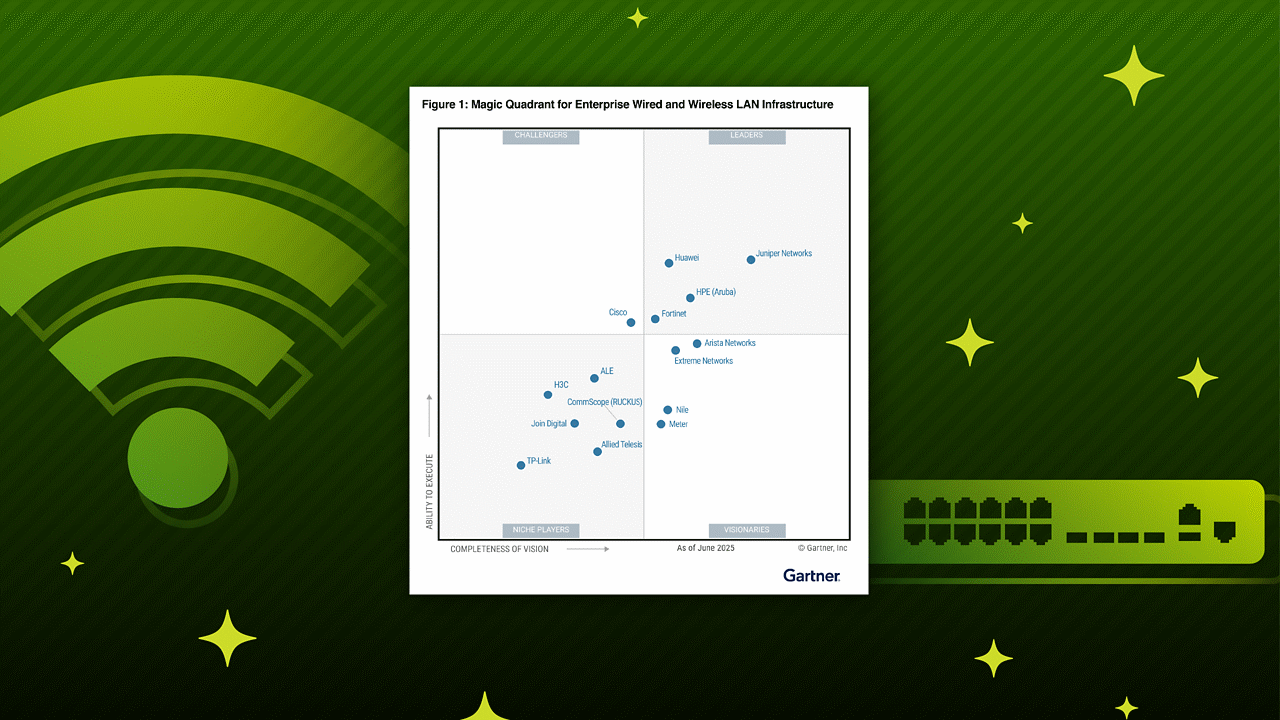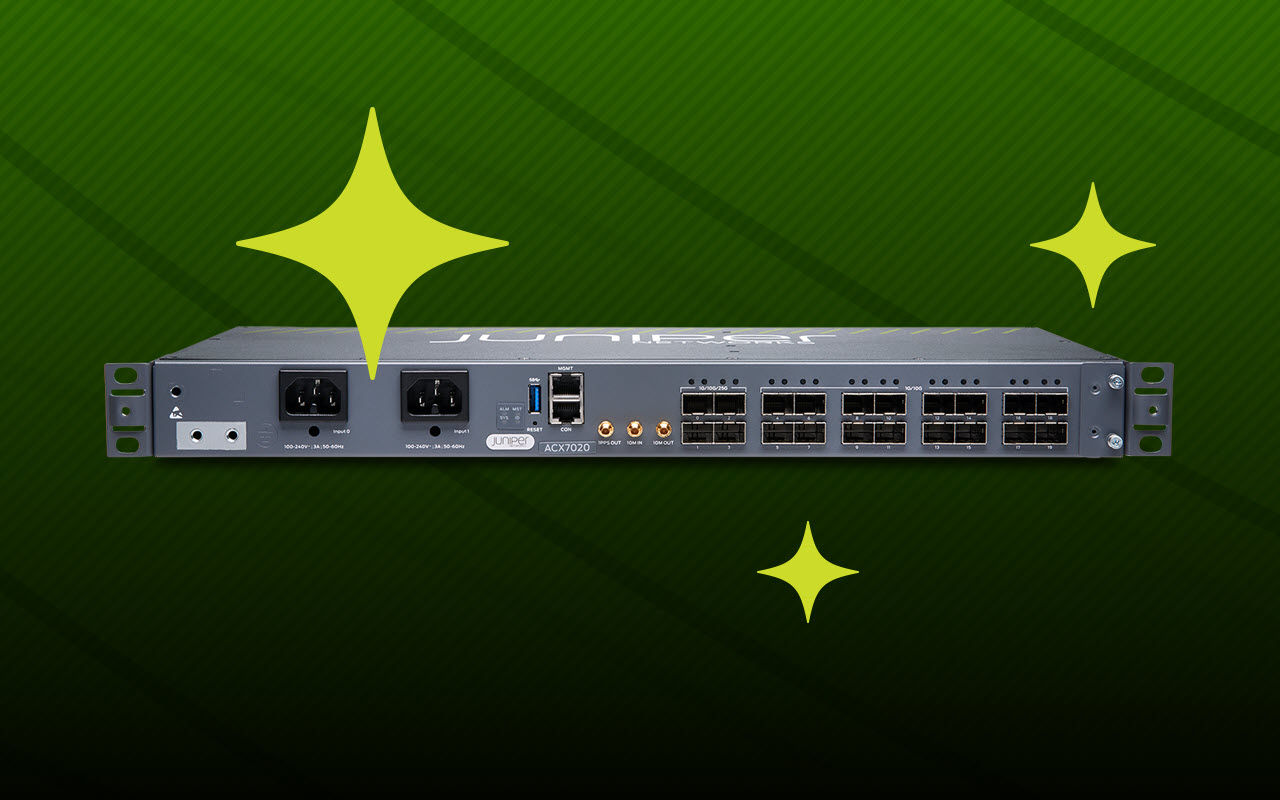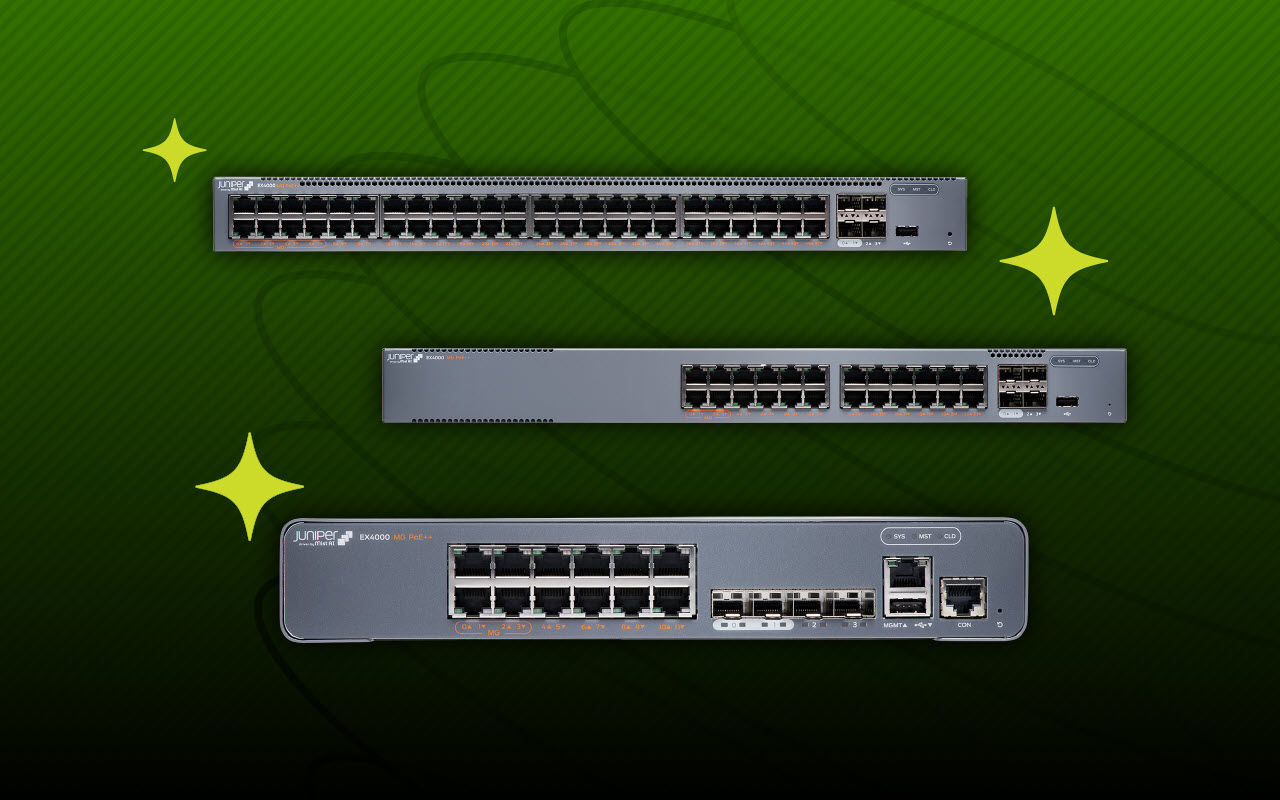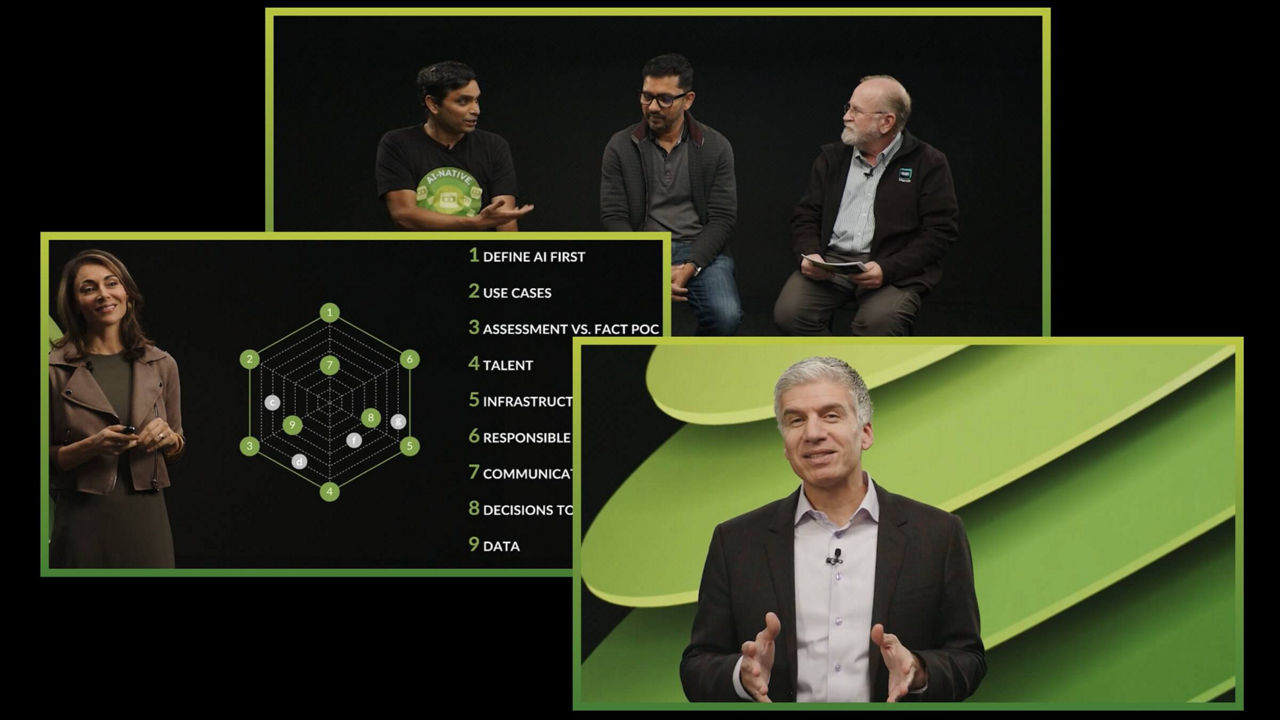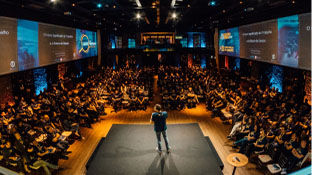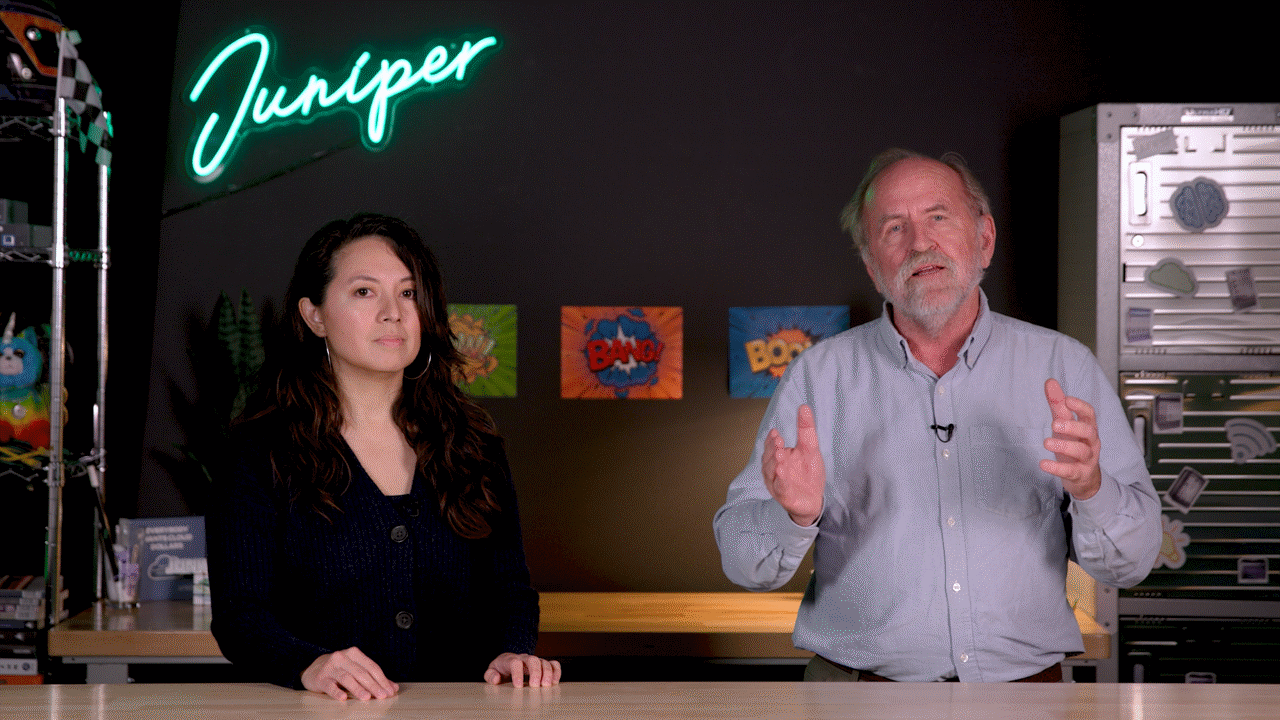QFX10000 Modular Ethernet Switches Datasheet
Download DatasheetProduct Overview
The QFX10000 line of modular data center spine and core Ethernet switches delivers industry-leading scale, flexibility and openness, with a design that enables the seamless transition from 10GbE and 40GbE interface speeds to 100GbE in data center and campus deployments. These high-performance, forward-looking switches are designed to help cloud and data center operators extract maximum value and intelligence from their network infrastructure well into the future.
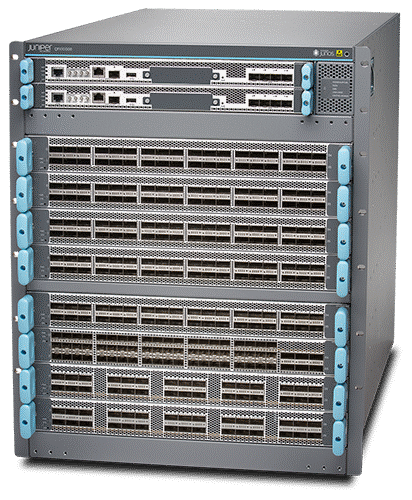
Product Description
The Juniper Networks® QFX10000 line of modular Ethernet switches delivers up to 96 Tbps of system throughput, scalable to over 200 Tbps in the future, to meet the rapid and ongoing traffic growth in the data center and campus deployments. Industry-leading scale and density on the QFX10000 modular switches redefine per-slot economics, enabling customers to do more with less while simplifying network design and reducing OpEx. Based on purpose-built Q5 ASICs, the QFX10000 line delivers unparalleled intelligence and analytics, providing deeper insights into application performance.
The QFX10000 line can be deployed in a number of different network designs and fabrics, including IP fabric with Ethernet VPN (EVPN)-Virtual Extensible LAN (VXLAN) and Juniper MC-LAG for Layer 2 and Layer 3 networks, giving customers complete architectural flexibility. Additionally, the open architecture ensures that customers can innovate on top of Juniper Networks Junos® operating system to accelerate the pace of innovation.
Two QFX10000 modular chassis options are available, providing full deployment flexibility:
- QFX10008 Ethernet Switch, an 8-slot, 13 U chassis that supports up to eight line cards
- QFX10016 Ethernet Switch, a 16-slot, 21 U chassis that supports up to 16 line cards
Both QFX10000 modular chassis can accommodate any combination of the following QFX10000 line cards:
- QFX10000-36Q, a 36-port 40GbE quad small form-factor pluggable plus transceiver (QSFP+) or 12-port 100GbE QSFP28 line card
- QFX10000-30C, a 30-port 100GbE QSFP28/40GbE QSFP+ line card
- QFX10000-60S-6Q, a 60-port 1GbE/10GbE SFP/SFP+ line card with six-port 40GbE QSFP+ / two-port 100GbE QSFP28
- QFX10000-30C-M, a 30-port 100GbE QSFP28/40GbE QSFP+ MACsec line card
- QFX10K-12C-DWDM, a 6-port 200GbE Coherent DWDM MACsec line card
Fully configured, a single QFX10016 chassis can support up to 480 100GbE ports, delivering the industry’s highest line-rate 100GbE port densities in its class. The QFX10000 switch fabric is capable of delivering up to 7.2 Tbps (full duplex) per slot, and the midplane- less orthogonal interconnect architecture ensures system longevity.
QFX10000 Modular Switches Highlights
- Industry-leading line-rate 100GbE port density with up to 480 100GbE ports in a single chassis
- Up to 96 Tbps Layer 2 and Layer 3 performance, scalable to over 200 Tbps in the future
- Unparalleled investment protection with high density 10GbE, 40GbE, and 100GbE
- System longevity with midplane-less orthogonal interconnect architecture
- Highest logical Layer 2 / Layer 3 scale; up to 1M MACs, 2 million host routes, 2 million FIB
- Deep buffers with up to 100ms packet buffering per port
- No head-of-line blocking with virtual output Queue (VoQ)-based architecture
- Flexible network architectures including Layer 3 fabric and Juniper MC-LAG for Layer 2 and Layer 3 networks
- Programmability through APIs
- High availability with non-stop routing (NSR), non-stop bridging (NSB), and graceful Routing Engine switchover (GRES)
- Rich automation capabilities with operations and event scripts, Python, Chef, Puppet, and Ansible
Architecture and Key Components
The QFX10000 modular data center spine and core Ethernet switches share a number of architectural elements. The Control Boards (CBs) employed by these switches run Junos OS, which processes all Layer 2 and Layer 3 protocols, while the Switch Fabric modules manage the chassis and provide switching functionality for data traffic coming from line cards.
The QFX10000 line cards, which are common across all modular QFX10000 platforms, include Packet Forwarding Engines (PFEs) that process network traffic, as well as a line-card processor that provides scalable local control.
The QFX10000 Virtual Output Queue (VOQ)-based architecture is designed to scale to very large deployments, with no head-of-line blocking, a single-tier low-latency switch fabric, efficient multicast replication handling, and deep buffering to ensure performance at scale. The horizontal line cards in the front of the chassis directly connect with the vertical switch fabric cards in the rear of the chassis via orthogonal interconnects, without the need for a midplane. This midplane-less architecture ensures a smooth upgrade process to higher-speed switch fabric cards in the future, providing unparalleled investment protection.
To maintain uninterrupted operation, the QFX10000 fan trays cool the line cards, Control Board, and Switch Fabric modules with redundant, variable-speed fans. In addition, the QFX10000 power supplies convert building power to the internal voltage required by the system.
All QFX10000 components are hot-swappable, and all central functions are available in redundant configurations, providing high operational availability by allowing continuous system operation during maintenance or repairs.
QFX10000 Line Cards
The QFX10000 line cards support an extensive set of Layer 2 and Layer 3 services that can be deployed in any combination of L2-L3 applications.
With these line cards, the QFX10000 line is unique in its ability to support tri-speed 10GbE, 40GbE, and 100GbE connections, enabling customers to transition seamlessly from one speed to another as their needs change. The unprecedented port density, high logical table sizes and up to 100ms deep packet buffers allow customers to deploy the most scalable systems necessary to meet the exponential data growth in the data center.
Each QFX10000 line card is built upon Juniper Q5 silicon, which supports a wide range of Layer 2 and Layer 3 Ethernet functionality including 802.1Q VLAN, VXLAN, link aggregation, Virtual Router Redundancy Protocol (VRRP), L2 to L3 mapping, and port monitoring. Additionally, the line cards support filtering, sampling, load balancing, rate limiting, class of service (CoS), MPLS, IP storage, and other key features needed to deploy a dependable, lossless, high-performance Ethernet infrastructure.
QFX10000 Control Board
The QFX10000 Control Board supports control and management plane functionality with an integrated Routing Engine (RE) that features a quad-core, 2.5 GHz Intel processor with 32 GB of SDRAM and an on-board solid-state drive (SSD) providing 32 GB of storage for Junos OS images and logs. The CB also has a front SSD slot to support a hot swappable SSD for secondary images and other external storage. The CB features AUX, console, and Ethernet ports on the front panel to support out-of-band system management and monitoring, while an external USB port provides a removable media interface to install Junos OS images manually.
The CB’s central CPU performs all system control functions and maintains hardware forwarding table and routing protocol states for the QFX10000 modular switches. Dedicated hardware on the CB module supports chassis management functions such as environmental monitoring, while communication between CB modules and individual line cards takes place over a dedicated internal 10GbE out-of-band control interface.
QFX10000 Switch Fabric
The QFX10000 Switch Fabric modules are hot-swappable and serve as the central non-blocking matrix through which all network data passes.
Both the QFX10008 and QFX10016 platforms have six Switch Fabric cards that provide N+1 redundancy. The Switch Fabric cards deliver 7.2 Tbps throughput per slot and can be upgraded to provide more than 200 Tbps of system throughput in the future.
Switch Fabric modules perform the following key functions:
- Monitor and control system functions
- Interconnect all line cards
- Handle clock and system resets
Power
The QFX10008 contains six power supply bays while the QFX10016 has ten power supply bays to provide complete flexibility for provisioning and redundancy. Each power supply has its own internal fan for cooling. All QFX10000 chassis support both AC and DC power supplies; however, AC and DC supplies cannot be mixed in the same chassis.
The AC supplies on the QFX10008 chassis accept 200 to 240 volts alternating current (VAC) input and deliver 2,700 watts of power to the chassis, while the DC power supplies accept -40 to -72 volts direct current (VDC) input and deliver 2,500 watts of power to the chassis. Each AC and DC power supply has two inputs for feed redundancy.
Cooling
The QFX10000 modular chassis support front-to-back cooling with air being pulled in through the perforations on the Control Boards and the line cards in the front of the chassis. Hot air is exhausted through the fan trays that are placed in front of the fabric cards in the rear of the chassis as well as through the power supplies.
Each chassis hosts two fan tray subsystems with redundant fans. Each fan tray subsystem consists of a fan tray controller and a fan tray. The fan tray controller provides power to the fan trays and manages the fans in the fan tray.
Flexible Network Architectures
The QFX10000 switches support a diverse set of deployment options, including Layer 3 fabric and Layer 2 and Layer 3 networks with Juniper multichassis link aggregation group (MC-LAG). Customers can choose the architecture that best suits their deployment needs and easily adapt and evolve as requirements change over time. The QFX10000 switches serve as the universal building block for all of these switching architectures, enabling data center operators to build cloud networks their way.
IP Fabric: For customers looking to build scale-out data centers, a Layer 3 spine and leaf Clos Fabric is ideal thanks to its non-blocking and predictable performance and scale characteristics. For example, a two-tier fabric with the QFX10000 switches as the spine and QFX5100 switches as leafs can scale to support more than 50,000 10GbE server ports at 3:1 oversubscription.
Overlays: Customers can deploy overlay networks to provide Layer 2 adjacencies for applications over Layer 3 fabrics. The overlay networks use VXLAN in the data plane and EVPN to program the overlays. The overlays can operate without a controller or can be orchestrated with a fabric management platform to provide L2/L3 overlay virtual networking and security for bare metal servers and virtual workloads. QFX10000 switches can also integrate with VMware NSX.
Juniper MC-LAG: The QFX10000 switches also eliminate Spanning Tree Protocol in traditional Layer 2 networks when deployed in an MC-LAG configuration. The active-active operation of MC-LAG ensures complete bandwidth utilization between the network’s access and aggregation layers, while the dual control plane technology ensures highest availability for applications.
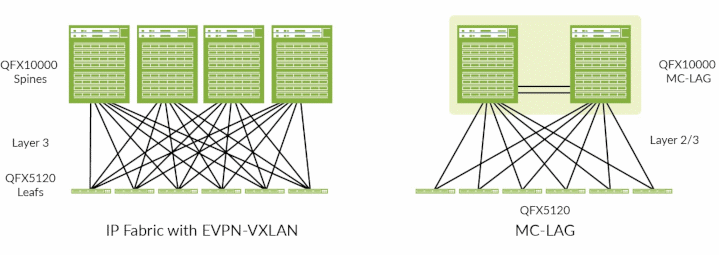
Figure 1: QFX10000 modular switches can be deployed in IP fabric or MC-LAG configurations.
Carrier-Class Operating System
The QFX10000 line of switches runs the same Junos OS used by all other Juniper Networks EX Series and QFX Series Ethernet Switches, as well as the Juniper Networks routers that power the world’s largest and most complex networks.
By using a common operating system, Juniper delivers a consistent implementation and operation of control plane features across all products. Junos OS employs a highly available modular architecture that prevents isolated failures from bringing down an entire system. Key Junos OS features that enhance the functionality and capabilities of the QXF10000 include
- Software modularity, with process modules running independently in their own protected memory space and with the ability to do process restarts
- Uninterrupted routing and forwarding with features such as nonstop routing (NSR) and nonstop bridging (NSB)
- Commit and rollback functionality that ensures error-free network configurations
- A powerful set of scripts for on-box problem detection, reporting, and resolution
Campus Deployments
Juniper Networks campus fabrics provide a single, standards-based Ethernet VPN-Virtual Extensible LAN (EVPN-VXLAN) solution that can be deployed in any campus, whether a two-tier network with a collapsed core distribution or a campus-wide system that involves multiple buildings with separate distribution and core layers.
The QFX10000 switches are ideal as campus distribution and core switches with 10GbE, 40GbE, and 100GbE ports supporting technologies like MC-LAG, EVPN multihoming, and EVPN-VXLAN.
Juniper campus fabrics support these validated architectures:
- MC-LAG and EVPN Multihoming (Collapsed Core/Distribution). A pair of interconnected QFX10000 switches can be deployed to provide EVPN multihoming (ESI-LAG) or multichassis link aggregation (MC-LAG) in a collapsed core/distribution configuration. This eliminates the need for Spanning Tree Protocol (STP) across the campus network by providing multihoming capabilities from the access to the distribution layer, while distribution to the core is an L3 IP fabric. ESI-LAG also supports horizontal scaling with more than two devices in the distribution layer and can extend EVPN to the core.
- Campus Fabric Core-Distribution. A pair of interconnected QFX10000 switches can provide EVPN L2 and L3 VXLAN gateway support. This eliminates the need for STP across the campus network by providing a multihoming capability from the access to the distribution layer, while distribution to the core is an L3 IP fabric using EVPN technology. The IP fabric can also extend to connect multiple enterprise buildings, while VXLAN allows stretching L2 across buildings. An IP Clos network between the distribution and the core layers can exist in two modes, both of which are supported by the QFX10000 switch:
- Centrally routed bridging overlay: An IRB interface placed at a central location in the fabric (in this case, a core device)
- Edge routed bridging overlay: An IRB interface placed at the edge of the fabric (in this case, a distribution device)
- Campus fabric IP Clos: The Campus fabric IP Clos architecture pushes VXLAN Layer 2/3 gateway functionality to the access layer. In this architecture, QFX10000 acts as an IP fabric distribution switch.

Figure 2: QFX10000 as distribution and core in EVPN multihoming and campus fabric architectures
QFX10000 Programmability
QFX10000 switches have an open software architecture that enables customers to innovate along with Juniper to accelerate the pace of innovation. Customers can create and run applications alongside Junos; these applications can then follow their own software release schedule.
This new solution offers modularity and direct programmability through APIs. The platform and Packet Forwarding Engine (PFE) modules are separate from the control module(s). Customers can run a guest application alongside the Junos OS and communicate with Junos as well as directly with the platform and PFE modules through normalized programmable APIs.
To support this, Juniper offers the Juniper Extension Toolkit (JET). Providing a modern, programmatic interface for developers of third-party applications on Junos devices, JET focuses on providing a standards-based interface to the Junos OS for customizing management and control plane functionality. The ability to build applications that can program the QFX10000 control plane, data plane, and the platform itself allows customers to implement specific and unique network forwarding functions and automate control and management by integrating with their orchestration tools. QFX10000 programmable APIs have a stable abstraction so that customer applications can work across Juniper platforms as well as future Junos releases.
Other services such as analytics and automation can also run as separate daemons and can be directly accessed through orchestration tools.
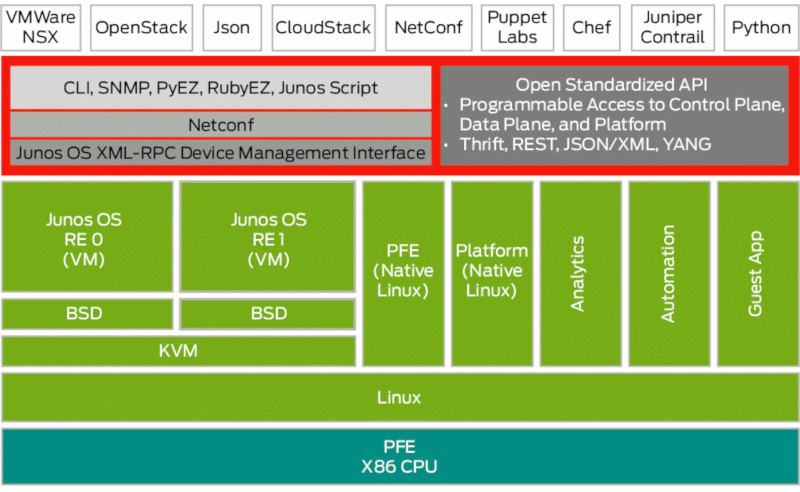
Figure 4: Juniper Programmability Framework
Management, Monitoring, and Analytics
Data Center Fabric Management: Apstra Data Center Director (formerly Juniper Apstra) provides operators with the power of intent-based network design to help ensure changes required to enable data center services can be delivered rapidly, accurately, and consistently. Operators can further benefit from the built-in assurance and analytics capabilities to resolve Day 2 operations issues quickly.
Data Center Director key features are:
- Automated deployment and zero-touch deployment
- Continuous fabric validation
- Fabric life-cycle management
- Troubleshooting using advanced telemetry
For more information, see Apstra Data Center Director.
Features and Benefits
High Availability
QFX10000 modular spine and core switches deliver a number of high availability features that ensure uninterrupted, carrier-class performance. Each QFX10000 chassis includes an extra slot to accommodate a redundant RE module that serves as a backup in hot-standby mode, ready to take over in the event of a primary RE failure. If the primary RE fails, the integrated Layer 2 and Layer 3 graceful Routing Engine switchover (GRES) feature of Junos OS, working in conjunction with the nonstop active routing (NSR) and nonstop bridging (NSB) features, ensures a seamless transfer of control to the backup, maintaining uninterrupted access to applications, services, and IP communications.
Virtual Output Queue (VOQ)
The QFX10000 switches support a virtual output queue (VOQ)-based architecture designed for very large deployments. VOQ refers to a queue on the egress port that is maintained by the ingress PFE. With VOQ architecture, packets are queued and dropped on ingress during congestion with no head-of-line blocking.
Automation
The QFX10000 switches support a number of features for network automation and plug-and-play operations. Features include operations and event scripts, automatic rollback, and support for Python and SLAX scripting languages. The switches can also support integration with VMware NSX, Tungsten Fabric, Puppet, and OpenStack.
MPLS
QFX10000 switches support a broad set of MPLS features, including L3 VPN, IPv6 provider edge router (6PE, 6VPE), RSVP traffic engineering, and LDP to allow standards-based network segmentation and virtualization.
EVPN-VXLAN
Using the QFX10000 L2 and L3 gateway services, customers can deploy overlay networks to provide L2 adjacencies for applications over L3 fabrics. The overlay networks use VXLAN in the data plane and EVPN for programming the overlays, which can operate without a controller or be orchestrated with a fabric management platform. QFX10000 switches can also interoperate with VMware NSX-T SDN controllers.
MACsec
MACsec encryption is supported on the QFX10000 switches using a built-in advanced Layer 2 encryption engine based on standard IEEE 802.1AE, 256-bit, and 128-bit Advanced Encryption Standard (AES) algorithms to secure all traffic communications. The QFX10000-30C-M line card offers line-rate 100GbE and 40GbE MACsec encryption on all ports, while the QFX10K-12C-DWDM Coherent DWDM line card supports line-rate 100GbE MACsec encryption up to 1.2 Tbps.
FCoE
As Fibre Channel over Ethernet (FCoE) transit switches, the QFX10000 line provides an IEEE data center bridging (DCB) converged network between FCoE-enabled servers and an FCoE-enabled Fibre Channel storage area network (SAN). The QFX10000 offers a full-featured DCB implementation that provides strong monitoring capabilities, helping SAN and LAN administration teams maintain clear management separation.
The FCoE transit switch functionality, including priority-based flow control (PFC) and Data Center Bridging Capability Exchange (DCBX), are included as part of the default software.
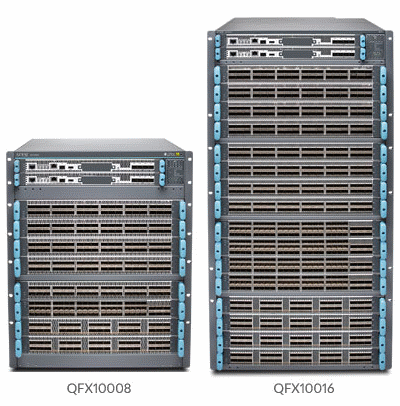
Specifications
Hardware
| QFX10008 | QFX10016 | |
| System throughput | Up to 48 Tbps | Up to 96 Tbps |
| Forwarding capacity | Up to 16 Bpps | Up to 32 Bpps |
| Maximum bandwidth/slot | 7.2 Tbps/slot | |
| Maximum 10GbE port density | 1,152 | 2,304 |
| Maximum 40GbE port density | 288 | 576 |
| Maximum 100GbE port density | 240 | 480 |
| QFX10008 | QFX10016 | |
Dimensions (W x H x D): | 17.4 x 22.55 x 32 in (44.2 x 57.3 x 81.3 cm) | 17.4 x 36.65 x 35 in (44.2 x 93 x 88.9 cm) |
| Rack units | 13 U | 21 U |
Weight: Base configuration Redundant configuration Fully loaded chassis |
280 lbs (127 kg) 322 lbs (146 kg) 493 lbs (224 kg) |
491 lbs (223 kg) 596 lbs (270 kg) 938 lbs (425 kg) |
| Architecture |
| |
| Operating System | Junos OS | |
| Control Board |
| |
| Total number of I/O slots | 8 | 16 |
| Fabric |
|
|
| Power | Holds up to six power supplies:
| Holds up to ten power supplies:
|
| Cooling |
| |
| Latency |
| |
| Warranty | Juniper standard one-year warranty | |

| QFX10000-36Q | QFX10000-30C | QFX10000-30C-M | QFX10000-60S-6Q | QFX10K-12C-DWDM | |
| Dimensions (W x H x D) | 17.2 x 1.89 x 20.54 in (43.7 x 4.8 x 52.2 cm) | 17.2 x 1.89 x 20.54 in (43.7 x 4.8 x 52.2 cm) | 17.2 x 1.89 x 20.54 in (43.7 x 4.8 x 52.2 cm) | 17.2 x 1.89 x 20.54 in (43.7 x 4.8 x 52.2 cm) | 17.2 x 1.89 x 20.54 in (43.7 x 4.8 x 52.2 cm) |
| Weight | 22.6 lbs (10.2 kg) | 27 lbs (12.2 kg) | 27.2 lbs (12.3 kg) | 21.4 lbs (9.7 kg) | 32 lb (14.5 kg) |
| Maximum 10GbE port density | 144 | 96 | N/A | 84 | - |
| Maximum 40GbE port density | 36 | 30 | 30 | 6 | - |
| Maximum 100GbE port density | 12 | 30 | 30 | 2 | 6 |
| Maximum 150/200GbE port density | - | - | - | - | 6 |
| Buffer | 12 GB | 12 GB | 12 GB | 8 GB | 12 GB |
| QFX10008 Typical Power | QFX10008 Reserved Power | QFX10016 Typical Power | QFX10016 Reserved Power | |
| Base system | 1,517 W | 2,500 W | 3,989 W | 5,815 W |
| Redundant system | 1,765 W | 2,877 W | 4,618 W | 6,630 W |
| Typical Power | Reserved Power | |
| QFX10000-36Q Line Card | 520 W | 675 W |
| QFX10000-30C Line Card | 890 W | 1,150 W |
| QFX10000-30C-M Line Card | 950 W | 1,250 W |
| QFX10000-60S-6Q Line Card | 365 W | 455 W |
| QFX10K-12C-DWDM Line Card | 900 W | 1,050 W |
| QFX10008 Switch Fabric | 170 W | 235 W |
| QFX10016 Switch Fabric | 510 W | 625 W |
| QFX10000 Control Board | 50 W | 100 W |
| QFX10008 Fan Tray | 225 W | 475 W |
| QFX10016 Fan Tray | 475 W | 975 W |
Software
| Scale | |
| Media access control (MAC) addresses | Up to 1 million |
| ARP entries | Up to 510,000, or 64,000 per PFE |
| Jumbo frames | 9,216 Bytes maximum |
| VLANs | 4,093 |
| Forwarding information base (FIB) (IPv4/IPv6) | Up to 2 million |
| Host routes | Up to 2 million |
| ECMP | 64-way |
| IPv4 Multicast routes | Up to 128,000 |
| IPv6 Multicast routes | Up to 128,000 |
| Multicast groups | Up to 128,000 |
| Filters | Up to 8,000 |
| Filter terms | Up to 64,000 |
| Policers | Up to 8,000 |
| Output queues per port | 8 |
| Virtual Output Queues | 384,000 per PFE |
| Link aggregation groups (LAG) | 1,000 |
| Distributed BFD sessions | 200/line card |
| Members / LAG | 64 |
| BGP neighbors (Premium Feature License) | 1,024 |
| GRE tunnels | 2,000 |
| VXLAN tunnels | 1,000 |
| MPLS Layer 3 VPNs (Advanced Feature License) | 4,096 |
| LSPs (ingress/egress/transit) (Advanced Feature License) | 4,000 |
| VRFs | 4,000 |
Layer 2 Features
- 802.1D – Spanning Tree Protocol (STP)
- 802.1w – Rapid Spanning Tree Protocol (RSTP)
- 802.1s – Multiple Spanning Tree Protocol (MSTP)
- VLAN Spanning Tree Protocol (VSTP)
- 802.1AB Link Layer Discovery Protocol (LLDP)
- VLAN Registration Protocol
- QinQ
Link Aggregation
- 802.3ad – Link Aggregation Control Protocol (LACP)
- Multi-chassis Link Aggregation (MC-LAG)
Layer 3 Features
- BGP (Premium Feature license or Advanced Feature license)
- Ethernet VPN (EVPN) Type 5
- Filter-based forwarding
- OSPF v1/v2
- OSPF v3
- Virtual Router Redundancy Protocol (VRRP)
- IPv6
- Bidirectional Forwarding Detection (BFD)
- Virtual routers
- Unicast reverse path forwarding (uRPF)
- Loop-free alternate (LFA)
- IS-IS (Premium Feature license or Advanced Feature license)
- DHCP v4/v6 relay
- VR-aware DHCP
- IPv4 / IPv6 over GRE tunnels (interface-based)
- Static routing
- RIP v1/v2
Multicast
- EVPN Type 6/7/8
- Internet Group Management Protocol (IGMP) v1/v2/v3
- Multicast Listener Discovery (MLD) v1/v2
- IGMP Proxy, Querier
- IGMP snooping
- MLD snooping
- Protocol Independent Multicast PIM-SM, PIM-SSM, PIM-DM
- Multicast Source Discovery Protocol (MSDP)
Firewall Filters
- Ingress and egress L2-L4 access control lists (ACLs):
- Port ACLs
- VLAN ACLs
- Router ACLs
- Control plane denial-of-service (DoS) protection
Quality of Service (QoS)
- Single rate three color policer
- Two rate three-color policer
- Congestion prevention:
- Weighted random early detection (WRED)
- Tail drop
- Explicit congestion notification (ECN) marking
- Priority-based scheduling:
- Low-latency queuing with strict high priority
- Weighted round-robin (WRR) queuing
MPLS (Advanced Feature License)
- LDP
- RSVP
- LDP tunneling (LDP over RSVP)
- Fast reroute (FRR)
- IPv6 tunneling (6PE)
- Ingress, transit, and egress label-switched paths (LSPs)
- IPv4 Layer 3 VPNs
- IPv6 Layer 3 VPNs (6VPE)
- Layer 2 circuits
Overlays (Premium Feature License or Advanced Feature License)
- EVPN-VXLAN
- VXLAN L2 and L3 gateway
- Integration with VMware NSX SDN controller
- Open vSwitch Database (OVSDB)
High Availability
- Graceful Routing Engine switchover (GRES)
- Nonstop active routing (NSR)
- Nonstop bridging (NSB)
Timing
- Precision Timing Protocol (PTP)
- Transparent clock
Visibility
- Switched Port Analyzer (SPAN)
- RSPAN
- ERSPAN
- Firewall filter-based port mirroring
- sFlow v5
- BGP Monitoring Protocol (BMP)
- IPFIX
Data Center Bridging
- Priority-based flow control (PFC)—IEEE 802.1Qbb
- Data Center Bridging Exchange Protocol (DCBX), DCBx FCoE, and iSCSI type, length, and value (TLVs)
Management and Operations
- Juniper Space® Network Director for Campus
- Junos OS CLI via console, telnet, SSH
- Out-of-band management: Serial; 10/100/1000BASE-T Ethernet
- Role-based CLI management and access
- Junos XML management protocol
- ASCII configuration file
- SNMP v1/v2/v3
- RADIUS
- TACACS+
- Extensive MIB support
- Junos OS configuration rescue and rollback
- Image rollback
- OpenStack Neutron Plug-in
- Puppet
- Chef
- Python
- Junos OS event, commit and OP scripts
- RMON (RFC 2819): Groups 1, 2, 3, 9
- Network Time Protocol (NTP)
- SSHv2
- Secure copy
- DNS resolver
- System logging
- Environment monitoring
- Temperature sensor
- Configuration backup via FTP/secure copy
Troubleshooting
- Debugging: CLI via console, telnet, or SSH
- Diagnostics: Show, debug, and statistics commands
- Port mirroring
- IP tools: Extended ping and trace
- Juniper Networks commit and rollback
IEEE Compliance
- IEEE 802.1AB: Link Layer Discovery Protocol (LLDP)
- IEEE 802.1ad: QinQ
- IEEE 802.1D-2004: Spanning Tree Protocol (STP)
- IEEE 802.1p: Class-of-service (CoS) prioritization
- IEEE 802.1Q: Virtual Bridged Local Area Networks
- IEEE 802.1s: Multiple Spanning Tree Protocol (MSTP)
- IEEE 802.1w: Rapid Spanning Tree Protocol (RSTP)
- IEEE 802.3: 10BASE-T
- IEEE 802.3u: 100BASE-T
- IEEE 802.3ab: 1000BASE-T
- IEEE 802.3z: 1000BASE-X
- IEEE 802.3ae: 10-Gigabit Ethernet
- IEEE 802.3ba: 40-Gigabit/100-Gigabit Ethernet
- IEEE 802.3ad: Link Aggregation Control Protocol (LACP)
- IEEE 802.1Qbb: Priority-based Flow Control
- IEEE 802.1Qaz: Enhanced Transmission Selection
RFC Compliance
- RFC 768: UDP
- RFC 783: Trivial File Transfer Protocol (TFTP)
- RFC 791: IP
- RFC 792: Internet Control Message Protocol (ICMP)
- RFC 793: TCP
- RFC 826: ARP
- RFC 854: Telnet client and server
- RFC 894: IP over Ethernet
- RFC 903: Reverse Address Resolution Protocol (RARP)
- RFC 906: TFTP Bootstrap
- RFC 951, 1542: BootP
- RFC 1027: Proxy ARP
- RFC 1058: RIP v1
- RFC 1112: IGMP v1
- RFC 1122: Host Requirements
- RFC 1142: OSI IS-IS Intra-domain Routing Protocol
- RFC 1256: IPv4 ICMP Router Discovery Protocol (IRDP)
- RFC 1492: TACACS+
- RFC 1519: Classless Interdomain Routing (CIDR)
- RFC 1587: OSPF NSSA Option
- RFC 1591: Domain Name System (DNS)
- RFC 1745: BGP4/IDRP for IP-OSPF Interaction
- RFC 1765: OSPF Database Overflow
- RFC 1771: Border Gateway Protocol 4
- RFC 1772: Application of the Border Gateway Protocol in the Internet
- RFC 1812: Requirements for IP Version 4 Routers
- RFC 1965: Autonomous System Confederations for BGP
- RFC 1981: Path maximum transmission unit (MTU) discovery for IPv6
- RFC 1997: BGP Communities Attribute
- RFC 2030: Simple Network Time Protocol (SNTP)
- RFC 2068: HTTP server
- RFC 2080: RIPng for IPv6
- RFC 2081: RIPng Protocol Applicability Statement
- RFC 2131: BOOTP/Dynamic Host Configuration Protocol (DHCP) relay agent and DHCP server
- RFC 2138: RADIUS Authentication
- RFC 2139: RADIUS Accounting
- RFC 2154: OSPF with Digital Signatures (password, Message Digest 5)
- RFC 2236: IGMP v2
- RFC 2267: Network Ingress Filtering
- RFC 2270: BGP-4 Dedicated autonomous system (AS) for sites/single provider
- RFC 2283: Multiprotocol Extensions for BGP-4
- RFC 2328: OSPF v2 (Edge mode)
- RFC 2338: VRRP
- RFC 2362: PIM-SM (Edge mode)
- RFC 2370: OSPF Opaque LSA Option
- RFC 2373: IPv6 Addressing Architecture
- RFC 2375: IPv6 Multicast Address Assignments
- RFC 2385: TCP MD5 Authentication for BGPv4
- RFC 2439: BGP Route Flap Damping
- RFC 2453: RIP v2
- RFC 2460: Internet Protocol, v6 (IPv6) specification
- RFC 2461: Neighbor Discovery for IP Version 6 (IPv6)
- RFC 2462: IPv6 Stateless Address Autoconfiguration
- RFC 2463: ICMPv6
- RFC 2464: Transmission of IPv6 Packets over Ethernet Networks
- RFC 2474: DiffServ Precedence, including 8 queues/port
- RFC 2526: Reserved IPv6 Subnet Anycast Addresses
- RFC 2545: Use of BGP-4 Multiprotocol Extensions for IPv6 Interdomain Routing
- RFC 2547: BGP/MPLS VPNs
- RFC 2597: DiffServ Assured Forwarding (AF)
- RFC 2598: DiffServ Expedited Forwarding (EF)
- RFC 2697: A Single Rate Three Color Marker
- RFC 2698: A Two Rate Three Color Marker
- RFC 2710: Multicast Listener Discovery (MLD) for IPv6
- RFC 2711: IPv6 Router Alert Option
- RFC 2740: OSPF for IPv6
- RFC 2796: BGP Route Reflection (supersedes RFC 1966)
- RFC 2796: Route Reflection
- RFC 2858: Multiprotocol Extensions for BGP-4
- RFC 2893: Transition Mechanisms for IPv6 Hosts and Routers
- RFC 2918: Route Refresh Capability for BGP-4
- RFC 3031: Multiprotocol Label Switching Architecture
- RFC 3032: MPLS Label Stack Encoding
- RFC 3036: LDP Specification
- RFC 3065: Autonomous System Confederations for BGP
- RFC 3176: sFlow
- RFC 3215: LDP State Machine
- RFC 3306: Unicast Prefix-based IPv6 Multicast Addresses
- RFC 3376: IGMP v3
- RFC 3392: Capabilities Advertisement with BGP-4
- RFC 3446: Anycast Rendevous Point (RP) Mechanism using PIM and MSDP
- RFC 3478: Graceful Restart for Label Distribution Protocol
- RFC 3484: Default Address Selection for IPv6
- RFC 3513: Internet Protocol Version 6 (IPv6) Addressing
- RFC 3569: PIM-SSM PIM Source Specific Multicast
- RFC 3587: IPv6 Global Unicast Address Format
- RFC 3618: Multicast Source Discovery Protocol (MSDP)
- RFC 3623: OSPF Graceful Restart
- RFC 3768: Virtual Router Redundancy Protocol (VRRP)
- RFC 3810: Multicast Listener Discovery Version 2 (MLDv2) for IP
- RFC 3973: PIM-Dense Mode
- RFC 4213: Basic Transition Mechanisms for IPv6 Hosts and Routers
- RFC 4291: IPv6 Addressing Architecture
- RFC 4360: BGP Extended Communities Attribute
- RFC 4364: BGP/MPLS IP Virtual Private Networks (VPNs)
- RFC 4443: ICMPv6 for the IPv6 specification
- RFC 4486: Sub codes for BGP Cease Notification message
- RFC 4552: Authentication/Confidentiality for OSPFv3
- RFC 4604: Using Internet Group Management Protocol Version 3 (IGMPv3)
- RFC 4724: Graceful Restart Mechanism for BGP
- RFC 4798: Connecting IPv6 Islands over IPv4 MPLS Using IPv6 Provider Edge Routers (6PE)
- RFC 4861: Neighbor Discovery for IPv6
- RFC 4862: IPv6 Stateless Address Autoconfiguration
- RFC 5095: Deprecation of Type 0 Routing Headers in IPv6
- RFC 5286, Basic Specification for IP Fast Reroute: Loop-Free Alternates
- RFC 5306: Restart Signaling for IS-IS
- RFC 5308: Routing IPv6 with IS-IS
- RFC 5340: OSPF for IPv6
- RFC 5880: Bidirectional Forwarding Detection
- RFC 7432: BGP MPLS-Based Ethernet VPN
- RFC 8365: A Network Virtualization Overlay Solution Using Ethernet VPN (EVPN)
- Draft-ietf-bess-evpn-prefix-advertisement-11
- Draft-ietf-bess-evpn-igmp-mld-proxy-05
Network Management—MIB Support
- RFC 1155: Structure of Management Information (SMI)
- RFC 1157: SNMPv1
- RFC 1212, RFC 1213, RFC 1215: MIB-II, Ethernet-like MIB, and traps
- RFC 1657: BGP-4 MIB
- RFC 1724: RIPv2 MIB
- RFC 1850: OSPFv2 MIB
- RFC 1901: Introduction to Community-based SNMPv2
- RFC 1902: Structure of Management Information for Version 2 of the Simple Network Management Protocol (SNMPv2)
- RFC 1905, RFC 1907: SNMP v2c, SMIv2, and Revised MIB-II
- RFC 2011: SNMPv2 for IP using SMIv2
- RFC 2012: SNMPv2 for transmission control protocol using SMIv2
- RFC 2013: SNMPv2 for user datagram protocol using SMIv2
- RFC 2096: IPv4 Forwarding Table MIB
- RFC 2287: System Application Packages MIB
- RFC 2465: Management Information Base for IP Version 6
- RFC 2570–2575: SNMPv3, user-based security, encryption, and authentication
- RFC 2576: Coexistence between SNMP Version 1, Version 2, and Version 3
- RFC 2578: SNMP Structure of Management Information MIB
- RFC 2579: SNMP Textual Conventions for SMIv2
- RFC 2665: Ethernet-like interface MIB
- RFC 2787: VRRP MIB
- RFC 2819: RMON MIB
- RFC 2863: Interface Group MIB
- RFC 2863: Interface MIB
- RFC 2922: LLDP MIB
- RFC 2925: Ping/Traceroute MIB
- RFC 2932: IPv4 Multicast MIB
- RFC 2933: Internet Group Management Protocol MIB
- RFC 2934: Protocol Independent Multicast MIB for IPv4
- RFC 3410: Introduction and Applicability Statements for Internet Standard Management Framework
- RFC 3411: An architecture for describing SNMP Management Frameworks
- RFC 3412: Message Processing and Dispatching for the SNMP
- RFC 3413: SNMP Application MIB
- RFC 3414: User-based Security Model (USM) for version 3 of SNMPv3
- RFC 3415: View-based Access Control Model (VACM) for the SNMP
- RFC 3416: Version 2 of the Protocol Operations for the SNMP
- RFC 3417: Transport Mappings for the SNMP
- RFC 3418: Management Information Base (MIB) for the SNMP
- RFC 3584: Coexistence between Version 1, Version 2, and Version 3 of the Internet-standard Network Management Framework
- RFC 3826: The Advanced Encryption Standard (AES) Cipher Algorithm in the SNMP
- RFC 4188: STP and Extensions MIB
- RFC 4444: Management Information Base for Intermediate System to Intermediate System (IS-IS)
- RFC 4363: Definitions of Managed Objects for Bridges with traffic classes, multicast filtering, and VLAN extensions
- Draft-ietf-idr-bgp4-mibv2-02.txt: Enhanced BGP-4 MIB
- Draft-reeder-snmpv3-usm-3desede-00
- Draft-ietf-bfd-mib-02.txt
Environmental Ranges
- Operating temperature: 32° to 104° F (0° to 40° C)
- Storage temperature: -40° to 158° F (-40° to 70° C)
- Operating altitude: Up to 10,000 ft (3,048 m)
- Relative humidity operating: 5 to 90% (noncondensing)
- Relative humidity nonoperating: 5 to 95% (noncondensing)
- Seismic: Designed to meet GR-63, Zone 4 earthquake requirements
Maximum Thermal Output
- QFX10008: 48,156 BTU/hour (14,113 W)
- QFX10016: 91,729 BTU/hour (26,883 W)
Safety and Compliance
Safety
- CAN/CSA-C22.2 No. 60950-1 Information Technology Equipment—Safety
- UL 60950-1 Information Technology Equipment—Safety
- EN 60950-1 Information Technology Equipment—Safety
- IEC 60950-1 Information Technology Equipment—Safety (All country deviations)
- EN 60825-1 Safety of Laser Products—Part 1: Equipment Classification
Electromagnetic Compatibility
- 47CFR Part 15, (FCC) Class A
- ICES-003 Class A
- EN 55022 Class A
- CISPR 22 Class A
- EN 55024
- CISPR 24
- EN 300 386
- VCCI Class A
- AS/NZA CISPR22 Class A
- KN22 Class A
- CNS 13438 Class A
- EN 61000-3-2
- EN 61000-3-3
ETSI
- ETSI EN 300 019: Environmental Conditions & Environmental Tests for Telecommunications Equipment
- ETSI EN 300 019-2-1 (2000)—Storage
- ETSI EN 300 019-2-2 (1999)—Transportation
- ETSI EN 300 019-2-3 (2003)—Stationary Use at Weather-protected Locations
- ETSI EN 300 019-2-4 (2003)—Stationary Use at Non-Weather-protected Locations
- ETS 300753 (1997)—Acoustic noise emitted by telecommunications equipment
Environmental Compliance
 Restriction of Hazardous Substances (ROHS) 6/6
Restriction of Hazardous Substances (ROHS) 6/6
 80 Plus Silver PSU Efficiency
80 Plus Silver PSU Efficiency
 Recycled material
Recycled material
 Waste Electronics and Electrical Equipment (WEEE)
Waste Electronics and Electrical Equipment (WEEE)
 Registration, Evaluation, Authorisation and Restriction of Chemicals (REACH)
Registration, Evaluation, Authorisation and Restriction of Chemicals (REACH)
 China Restriction of Hazardous Substances (ROHS)
China Restriction of Hazardous Substances (ROHS)
Juniper Networks Services and Support
Juniper Networks is the leader in performance-enabling services that are designed to accelerate, extend, and optimize your high-performance network. Our services allow you to maximize operational efficiency while reducing costs and minimizing risk, achieving a faster time to value for your network. Juniper Networks ensures operational excellence by optimizing the network to maintain required levels of performance, reliability, and availability. For more details, please visit https://www.juniper.net/us/en/products.html
Ordering Information
| Product Number | Description |
| QFX10000 Hardware | |
| QFX10008-REDUND | QFX10008 redundant 8-slot chassis with 2 CBs, 6 2,700 W AC power supplies, 2 fan trays, 2 fan tray controllers, and 6 switch fabric cards |
| QFX10008-REDUND-H | QFX10008 Redundant 8-slot chassis with 2 CBs, 6 HVDC-capable power supplies, 2 fan trays, 2 fan tray controllers, and 6 switch fabric cards |
| QFX10008-BASE | QFX10008 Base 8-slot chassis with 1 CB, 3 2,700 W AC power supplies, 2 fan trays, 2 fan tray controllers, and 5 switch fabric cards |
| QFX10008-BASE-H | QFX10008 Base 8-slot chassis with 1 CB, 3 HVDC-capable power supplies, 2 fan trays, 2 fan tray controllers, and 5 switch fabric cards |
| QFX10008-REDUND-DC | QFX10008 Redundant 8-slot chassis with 2 CBs, 6 2,500 W DC power supplies, 2 fan trays, 2 fan tray controllers, and 6 switch fabric cards |
| QFX10016-REDUND | QFX10016 Redundant 16-slot chassis with 2 CBs, 10 2,700 W AC power supplies, 2 fan trays, 2 fan tray controllers, and 6 switch fabric cards |
| QFX10016-BASE | QFX10016 Base 16-slot chassis with 1 CB, 5 2,700 W AC power supplies, 2 fan trays, 2 fan tray controllers, and 5 switch fabric cards |
| QFX10016-REDUND-DC | QFX10016 Redundant 16-slot chassis with 2 CBs, 10 2,500 W DC power supplies, 2 fan trays, 2 fan tray controllers, and 6 switch fabric cards |
| QFX10000 Line Cards | |
| QFX10000-36Q | QFX10000 36-port 40GbE QSFP+ / 12-port 100GbE QSFP28 line card |
| QFX10000-30C | QFX10000 30-port 100GbE QSFP28/40GbE QSFP+ line card |
| QFX10000-30C-M | QFX10000 30-port 100GbE QSFP28/40GbE QSFP+ MACsec line card |
| QFX10000-60S-6Q | QFX10000 60-port 1/10GbE SFP/SFP+ line card with 6 40GbE QSFP+ / 2 100GbE QSFP28 ports |
| QFX10K12C-DWDM | QFX10000 1.2 Tbps 6-port 200GbE line rate Coherent DWDM MACsec line card |
| JNP-QSFP-100G-SR4 | QSFP28 100GBASE-SR4 Optics for up to 100 m transmission over parallel multi-mode fiber (MMF) |
| JNP-QSFP-100G-LR4 | QSFP28 100GBASE-LR4 Optics for up to 10 km transmission over serial single-mode fiber (SMF) |
| JNP-QSFP-100G-PSM4 | QSFP28 100GBASE-PSM4 Optics for up to 2 km transmission over parallel SMF |
| JNP-QSFP-100G-CWDM | QSFP28 100GBASE-CWDM4 Optics for up to 2 km transmission over serial SMF |
| JNP-QSFP-40GE-IR4 | QSFP+ 40GBASE-IR4 40 Gigabit optics, 1,310 nm for up to 2 km transmission on SMF |
| JNP-QSFP-40G-LR4 | QSFP+ 40GBASE-LR4 40 Gigabit optics, 1,310 nm for up to 10 km transmission on SMF |
| JNP-QSFP-40G-LX4 | QSFP+ 40GBASE-LX4 40 Gigabit optics, 100 m (150 m) with OM3 (OM4) duplex MMF fiber |
| JNP-QSFP-4X10GE-IR | QSFP+ 40GBASE Optics, up to 1.4 km transmission on parallel single mode (4X10GbE long reach up to 1.4 km) |
| JNP-QSFP-4X10GE-LR | QSFP+ 40GBASE optics, up to 10 km transmission on parallel single mode (4X10GbE long reach up to 10 km) |
| QFX-QSFP-40G-ESR4 | QSFP+ 40GBASE-ESR4 40 Gigabit optics, 300 m (400 m) with OM3 (OM4) MMF |
| QFX-QSFP-40G-SR4 | QSFP+ 40GBASE-SR4 40 Gigabit optics, 850 nm for up to 150 m transmission on MMF |
| QFX-SFP-10GE-LR | SFP+ 10GBASE-LR 10-Gigabit Ethernet optics, 1,310 nm for 10 km transmission on SMF |
| QFX-SFP-10GE-SR | SFP+ 10GBASE-SR 10-Gigabit Ethernet optics, 850 nm for up to 300 m transmission on MMF |
| QFX-SFP-10GE-USR | SFP+ 10-Gigabit Ethernet ultra short reach optics, 850 nm for 10 m on OM1, 2 0 m on OM2, 100 m on OM3 multi-mode fiber |
| QFX-SFP-1GE-LX | SFP 1000BASE-LX Gigabit-Ethernet optics, 1,310 nm for 10 km transmission on SMF |
| QFX-SFP-1GE-SX | SFP 1000BASE-SX Gigabit-Ethernet optics, 850 nm for up to 550 m transmission on MMF |
| QFX-SFP-1GE-T | SFP 1000BASE-T Copper transceiver module for up to 100 m transmission on Cat5 |
| QFX10000 Software Feature Licenses | |
| QFX10008-PFL | QFX10008 Premium Feature License |
| QFX10008-AFL | QFX10008 Advanced Feature License |
| QFX10016-PFL | QFX10016 Premium Feature License |
| QFX10016-AFL | QFX10016 Advanced Feature License |
| QFX10000-30C-LFIB | 1 million FIB license for QFX10000-30C and QFX10000-30C-M line cards |
| QFX10000-36Q-LFIB | 1 million FIB license for QFX10000-36Q and QFX10K-12C-DWDM line cards |
| QFX10000-60S-LFIB | 1 million FIB license for QFX10000-60S-6Q line card |
| QFX10000 Power Cords | |
| CBL-EX-PWR-C19-AR | AC Power Cable - Argentina (16A/250V, 2.5m) |
| CBL-EX-PWR-C19-AU | AC Power Cable - Australia (15A/250V, 2.5m) |
| CBL-EX-PWR-C19-BR | AC Power Cable - Brazil (16A/250V, 2.5m) |
| CBL-EX-PWR-C19-C20 | AC Patch Cable - C20 PDU (16A/250V, 2.5m) |
| QFX-SFP-10GE-SR | SFP+ 10GBASE-SR 10-Gigabit Ethernet optics, 850 nm for up to 300 m transmission on MMF |
| QFX-SFP-10GE-USR | SFP+ 10-Gigabit Ethernet ultra short reach optics, 850 nm for 10 m on OM1, 2 0 m on OM2, 100 m on OM3 multi-mode fiber |
| QFX-SFP-1GE-LX | SFP 1000BASE-LX Gigabit-Ethernet optics, 1,310 nm for 10 km transmission on SMF |
| QFX-SFP-1GE-SX | SFP 1000BASE-SX Gigabit-Ethernet optics, 850 nm for up to 550 m transmission on MMF |
| QFX-SFP-1GE-T | SFP 1000BASE-T Copper transceiver module for up to 100 m transmission on Cat5 |
| QFX10000 Software Feature Licenses | |
| QFX10008-PFL | QFX10008 Premium Feature License |
| QFX10008-AFL | QFX10008 Advanced Feature License |
| QFX10016-PFL | QFX10016 Premium Feature License |
| QFX10016-AFL | QFX10016 Advanced Feature License |
| QFX10000-30C-LFIB | 1 million FIB license for QFX10000-30C and QFX10000-30C-M line cards |
| QFX10000-36Q-LFIB | 1 million FIB license for QFX10000-36Q and QFX10K-12C-DWDM line cards |
| QFX10000-60S-LFIB | 1 million FIB license for QFX10000-60S-6Q line card |
| QFX10000 Power Cords | |
| CBL-EX-PWR-C19-AR | AC Power Cable - Argentina (16A/250V, 2.5m) |
| CBL-EX-PWR-C19-AU | AC Power Cable - Australia (15A/250V, 2.5m) |
| CBL-EX-PWR-C19-BR | AC Power Cable - Brazil (16A/250V, 2.5m) |
| CBL-EX-PWR-C19-C20 | AC Patch Cable - C20 PDU (16A/250V, 2.5m) |
About Juniper Networks
Juniper Networks is leading the convergence of AI and networking. Mist™, Juniper’s AI-native networking platform is purpose-built to run AI workloads and simplify IT operations, assuring exceptional and secure user and application experiences—from the edge to the data center, to the cloud. Additional information can be found at www.juniper.net, X, LinkedIn, and Facebook.
1000529 - 023-EN JULY 2025




